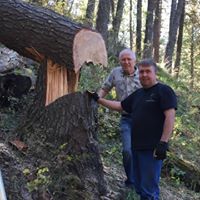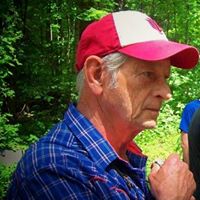Loren D Nelson
age ~84
from Lochbuie, CO
Loren Nelson Phones & Addresses
- Lochbuie, CO
- Northglenn, CO
- Palmetto, FL
- Lochbuie, CO
- Weldona, CO
Work
-
Company:Ophir corporation
-
Address:10184 W Belleview Ave # 200, Littleton, CO 80127
-
Phones:(610)4374471
-
Position:President
-
Industries:Aircraft Parts and Auxiliary Equipment, Measuring and Controlling Devices
Us Patents
-
Method And Apparatus For Measuring Atmospheric Temperature
view source -
US Patent:6409198, Jun 25, 2002
-
Filed:Oct 12, 1999
-
Appl. No.:09/416565
-
Inventors:Carl Scott Weimer - Littleton CO
Stuart Paul Beaton - Littleton CO
Martin Joseph OBrien - Pine CO
Loren Dean Nelson - Evergreen CO -
Assignee:Ophir Corporation - Littleton CO
-
International Classification:G01J 502
-
US Classification:28033904, 25033901
-
Abstract:An advance in a passive, remote sensing device for measurement of atmospheric temperature utilizes an actuated modulator for periodically alternating the radiation detected by a detector at a selected infrared wavelength between the infrared radiation from the atmosphere and that from the infrared reference radiation emitted from a reference material such that the detector compares the radiation emitted from the atmosphere to that emitted by the reference material at the selected infrared wavelength in order to determine the atmosphere temperature. Preferably, the modulator is a MEMS based modulator having a movable grating formed by MEMS based fabrication techniques.
-
Oil And Gas Exploration System And Method For Detecting Trace Amounts Of Hydrocarbon Gases In The Atmosphere
view source -
US Patent:6509566, Jan 21, 2003
-
Filed:Jun 22, 2000
-
Appl. No.:09/602096
-
Inventors:Paula R. Wamsley - Littleton CO
Carl S. Weimer - Littleton CO
Loren D. Nelson - Evergreen CO
Martin J. OBrien - Pine CO -
Assignee:Ophir Corporation - Littleton CO
-
International Classification:G01N 2145
-
US Classification:2503385, 2503418
-
Abstract:An oil and gas exploration system and method for land and airborne operations, the system and method used for locating subsurface hydrocarbon deposits based upon a remote detection of trace amounts of gases in the atmosphere. The detection of one or more target gases in the atmosphere is used to indicate a possible subsurface oil and gas deposit. By mapping a plurality of gas targets over a selected survey area, the survey area can be analyzed for measurable concentration anomalies. The anomalies are interpreted along with other exploration data to evaluate the value of an underground deposit. The system includes a differential absorption lidar (DIAL) system with a spectroscopic grade laser light and a light detector. The laser light is continuously tunable in a mid-infrared range, 2 to 5 micrometers, for choosing appropriate wavelengths to measure different gases and avoid absorption bands of interference gases. The laser light has sufficient optical energy to measure atmospheric concentrations of a gas over a path as long as a mile and greater.
-
Methods Of And Apparatus For Detecting Low Concentrations Of Target Gases In The Free Atmosphere
view source -
US Patent:6750453, Jun 15, 2004
-
Filed:May 25, 2002
-
Appl. No.:10/155770
-
Inventors:Loren D. Nelson - Evergreen CO
Martin J. OBrien - Pine CO -
Assignee:Ophir Corporation - Littleton CO
-
International Classification:G01N 2117
-
US Classification:2503385, 2504581
-
Abstract:A source directs broadband modulated light into a region the free atmosphere in which target gas may be present. A gas correlation radiometer responds to light transmitted through the region. Separate radiometer channels respond to a single beam of light after transmission through the region. A beam splitter separates the beam into two beams, one directed into each of the channels. The two channels separately and simultaneously respond to a respective one of the light beams for separately and simultaneously generating signals that together indicate whether the target gas is in the free atmosphere. A method provides an optimal bandpass of an IR filter that filters the light before transmission to the radiometers. Another method uses a null factor in computing an output that determines the concentration of the target gas in the free atmosphere. Long distance detection embodiments may be borne by vehicles such as trucks or aircraft.
-
Method Of Optimizing A Response Of A Gas Correlation Radiometer To A Trace Amount Of A Target Gas
view source -
US Patent:6822236, Nov 23, 2004
-
Filed:Mar 18, 2004
-
Appl. No.:10/803389
-
Inventors:Loren D. Nelson - Evergreen CO
Martin J. OBrien - Pine CO -
Assignee:Ophir Corporation - Littleton CO
-
International Classification:G01N 2135
-
US Classification:2503385, 2503381
-
Abstract:A method optimizes gas correlation radiometer response to trace amounts of target gas in the free atmosphere in competition with interfering gas. Operations identify spectral regions of a first absorption spectrum of the target gas, and of a second absorption spectrum of the interfering gas. A set of similarity data is determined as a function of overlap regions within the spectral region, and a set of contrast data is determined as a function of non-overlap regions within the spectral region, including a plurality of data items within each of a plurality of bandwidths, and a data item corresponding to a center wavelength within each bandwidth. Graphs correspond to each bandwidth. From one graph a center wavelength of an infrared filter is selected, and from another graph there is selected a bandwidth of the infrared filter, to configure an infrared filter for use with the gas correlation radiometer.
-
Rear-Looking Apparatus And Method For Detecting Contrails
view source -
US Patent:52852563, Feb 8, 1994
-
Filed:Jul 28, 1992
-
Appl. No.:7/921502
-
Inventors:Loren D. Nelson - Evergreen CO
David C. MacPherson - Conifer CO -
Assignee:Ophir Corporation - Littleton CO
-
International Classification:G01C 300
-
US Classification:356342
-
Abstract:Contrail detection aft of an aircraft is provided by a rear-looking ranging system carried by the aircraft. A randomly modulated laser beam is directed into a detection volume aft of the aircraft for scatter back toward a detector on the aircraft. Bistatic mounting of a laser and a telescope of the detector preclude sensing of the scattered beam forward of the detection volume. Processing of the detected scattered beam includes cross correlation and analysis to indicate the formation of the contrail aft of the aircraft.
-
Microwave Radiometer And Methods For Sensing Atmospheric Moisture And Temperature
view source -
US Patent:48734810, Oct 10, 1989
-
Filed:Feb 16, 1988
-
Appl. No.:7/156614
-
Inventors:Loren D. Nelson - Morrison CO
Lee A. Erb - Boulder CO
Randolph H. Ware - Boulder CO
Donald Rottner - Littleton CO -
Assignee:Radiometrics Corporation - Littleton CO
-
International Classification:G01W 102
G01W 108 -
US Classification:324 585R
-
Abstract:A passive, multi-channel microwave radiometer includes an antenna-lens assembly for receiving, and a first waveguide designed to provide a common path for propagating, 23. 8 GHz and 31. 4 GHZ atmospheric signals. The 23. 8 GHz signal is above the frequency of relative maximum water vapor absorption and the 31. 4 GHz signal is near a relative minimum in the water vapor absorption spectrum. Circuitry is responsive to the atmospheric signals for generating output signals representing the respective water vapor and liquid content in and the temperature of the atmosphere. For realtime calibration a blackbody assembly is mounted in the near field of the antenna-lens assembly. The blackbody assembly emits known blackbody microwave signals at 23. 8 GHz, 31. 4 GHz and in the V band. The radiometer is calibrated during its normal operation by causing a mirror to select the blackbody signals for propagation along the common path.
-
Method And Apparatus For Generating High Power Laser Pulses In The Two To Six Micron Wavelength Range
view source -
US Patent:55838774, Dec 10, 1996
-
Filed:May 9, 1995
-
Appl. No.:8/437676
-
Inventors:David C. MacPherson - Conifer CO
Loren D. Nelson - Evergreen CO
Martin J. O'Brien - Bailey CO -
Assignee:Ophir Corporation - Littleton CO
-
International Classification:H01S 330
-
US Classification:372 4
-
Abstract:Apparatus performs a method of generating one or more output laser pulses in a range of 2 to 6 microns. When a plurality of the output laser pulses are generated, a first output pulse has any selected wavelength within the range and a second output pulse is temporally closely spaced relative to the first output pulse and has a chosen wavelength differing from the selected wavelength. An oscillator laser cavity is provided with a tunable oscillator rod capable of generating initial laser pulses within a range of from 750 to 1000 nm, and a tuning element is coupled to the rod. A flashlamp is operable to pump the rod. For two pulse operation, the flashlamp has a given duration. A Q-switch provides the initial laser pulses upon operation of the tuning element and the flashlamp. A Raman device coupled to the rod shifts the wavelength of such initial laser pulse into the range of from 2 to 6 microns to form the output laser pulse having a wavelength within the range. For multiple pulses, a controller causes the Q-switch to provide first and second ones of the initial laser pulses, spaced by a time interval less than the given duration.
-
Profiling Of Selected Atmospheric Characteristics Utilizing Passive Microwave Remote Sensing
view source -
US Patent:55266762, Jun 18, 1996
-
Filed:Feb 7, 1995
-
Appl. No.:8/385140
-
Inventors:Fredrick S. Solheim - Boulder CO
Lee A. Erb - Longmont CO
Loren D. Nelson - Evergreen CO
Randolph H. Ware - Boulder CO -
Assignee:Radiometrics Corporation - Boulder CO
-
International Classification:G01W 100
-
US Classification:73 2901
-
Abstract:Apparatus and methods for profiling atmospheric temperature, water vapor and/or cloud liquid content utilizing passive microwave remote sensing are disclosed. The apparatus includes an antenna for receiving atmospheric microwave emissions having frequencies of interest, a highly stable, tunable frequency synthesizer, and downconverting system receiving selected frequency outputs from the synthesizer and the received emissions and, responsive thereto, providing output signals indicative of the frequencies of interest and representing the profile.
Resumes

Loren Nelson
view source
Loren Nelson
view source
Loren Nelson
view source
Loren Nelson
view source
Loren Nelson
view source
Retired
view sourceIndustry:
Management Consulting

Loren Nelson
view source
Loren Nelson
view sourceName / Title
Company / Classification
Phones & Addresses
President
Ophir Corporation
Aircraft Parts and Auxiliary Equipment, Measu...
Aircraft Parts and Auxiliary Equipment, Measu...
10184 W Belleview Ave # 200, Littleton, CO 80127
Website: ophir.com
Website: ophir.com
Editor
The Herald Bradenton Inc
Newspapers-Publishing/Printing
Newspapers-Publishing/Printing
102 Manatee Ave W, Bradenton, FL 34205
PO Box 921, Bradenton, FL 34206
(941)7480411
PO Box 921, Bradenton, FL 34206
(941)7480411
Myspace
Flickr

Loren Nelson
view source
Loren Nelson
view source
Loren Nelson
view source
Loren Nelson
view source
Loren Nelson
view source
Loren S. Nelson
view source
Loren Nelson
view source
Loren Nelson
view sourcePlaxo

Loren Nelson
view sourceNelsonecom
Classmates

Loren Nelson
view sourceSchools:
Santiago High School Corona CA 2004-2008

Loren Nelson
view sourceSchools:
Opheim High School Opheim MT 2000-2004
Community:
Cindy Lonz, James Pehan, Darcy Gaub, Wayne Johnson

Loren Nelson
view sourceSchools:
Medicine Lake High School Medicine Lake MT 1975-1978
Community:
Kyle Edgerton, Garry Green, Lori Edwards, Ramona Doll

Loren Nelson
view sourceSchools:
Mt. Vernon Academy Mt. Vernon OH 1985-1989
Community:
Sarah Hajduk, Daniel West, Jeanne Schultz, Jerry Bell

Loren Nelson
view sourceSchools:
Medicine Lake High School Medicine Lake MT 1974-1978
Community:
Kyle Edgerton, Garry Green, Lori Edwards, Ramona Doll

Loren Nelson
view sourceSchools:
Celina High School Celina TX 1992-1996
Community:
Susan Matlock, Maritza Acevedo, Lesley Coleman

Loren Nelson, Ballard Hig...
view sourceGoogleplus

Loren Nelson

Loren Nelson

Loren Nelson

Loren Nelson

Loren Nelson

Loren Nelson
About:
Loren Nelson, Director, Scripture Distributors Mission, 8421 Nelson Road, Britt, Minnesota 55710 USA , a charity raising funds for orphans and natural disaster victims. Other email is lcnelson05@hot...
Youtube
Get Report for Loren D Nelson from Lochbuie, CO, age ~84



















